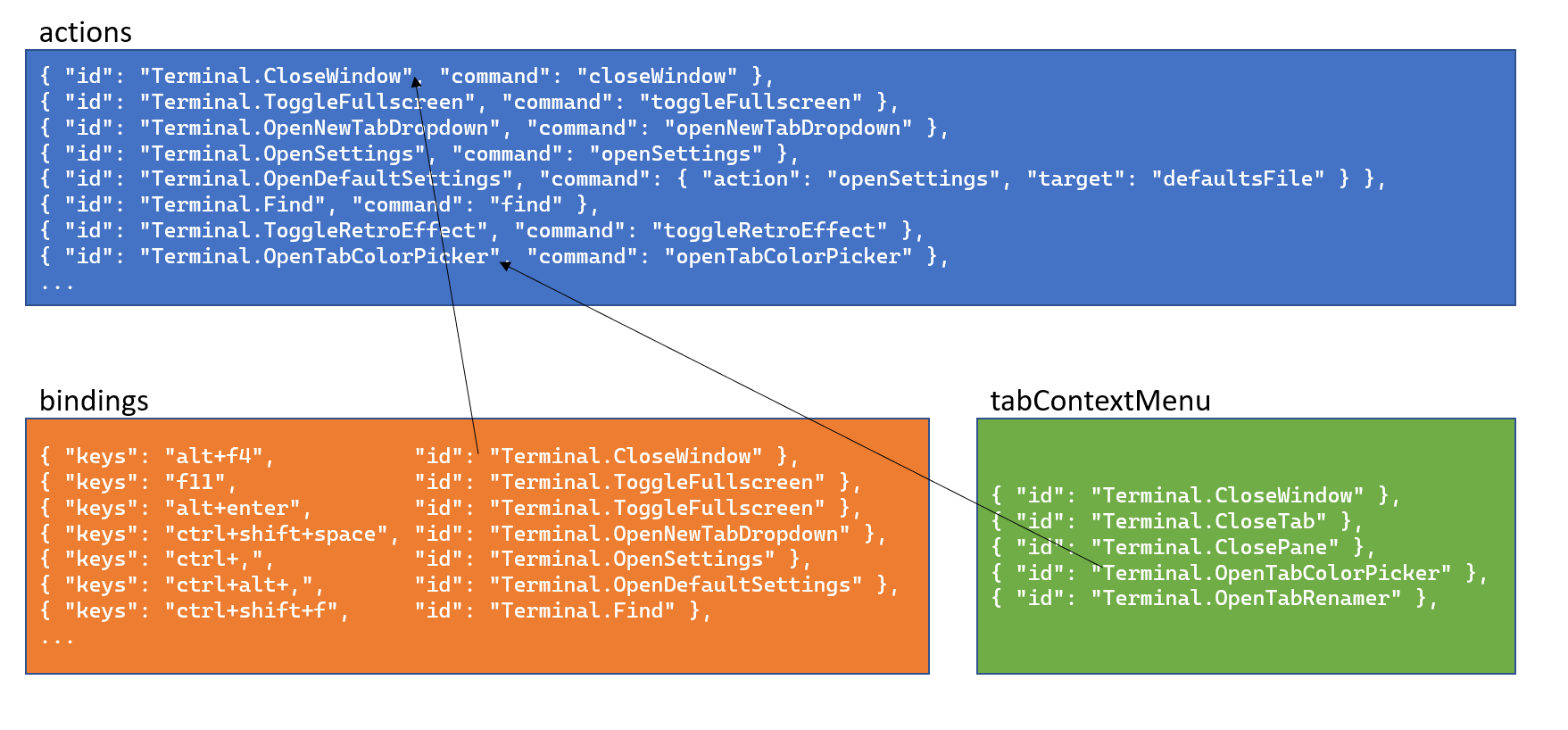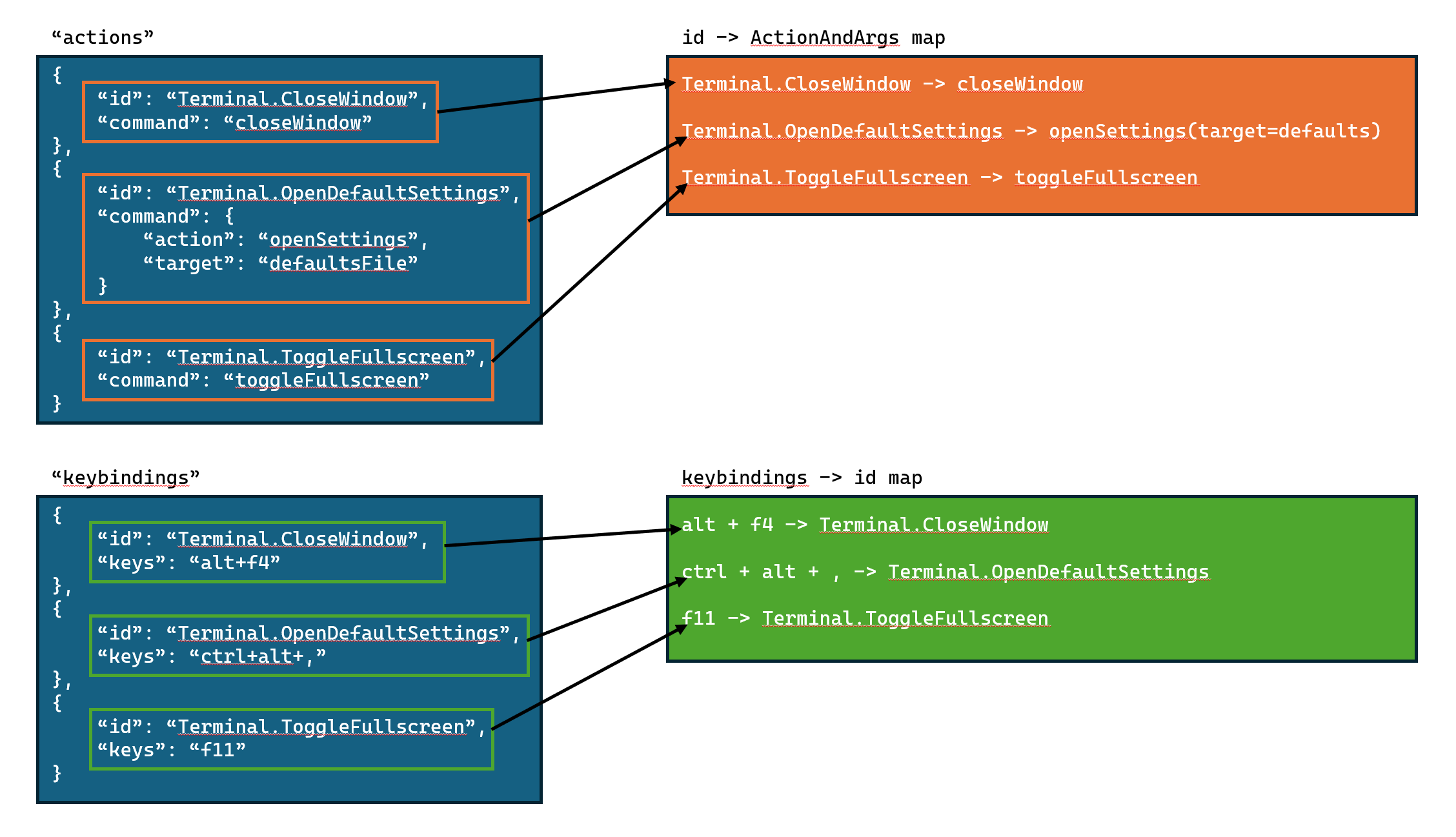11 KiB
| author | created on | last updated | issue id |
|---|---|---|---|
| Mike Griese @zadjii-msft | 2020-07-13 | 2020-07-22 | 6899 |
Action IDs
Abstract
This document is intended to serve as an addition to the Command Palette Spec, as well as the New Tab Menu Customization Spec.
As we come to rely more on actions being a mechanism by which the user defines "do something in the Terminal", we'll want to make it even easier for users to re-use the actions that they've already defined, as to reduce duplicated json as much as possible. This spec proposes a mechanism by which actions could be uniquely identifiable, so that the user could refer to bindings in other contexts without needing to replicate an entire json blob.
Solution Design
This spec was largely inspired by the following diagram from @DHowett:
The goal is to introduce an id parameter by which actions could be uniquely
referred to. If we'd ever like to use an action outside the list of actions, we
can simply refer to the action's ID, allowing the user to only define the action
once.
We'll start by renaming bindings to actions. bindings was suggested as a
rename for keybindings in #6532, as a way to make the name more generic.
Discussion with the team lead to the understanding that the name actions would
be even better, as a way of making the meaning of the "list of actions" more
obvious.
We will then restructure defaults.json, and also users' settings files (via fixUpUserSettings), in the following manner:
- Instead of each
commandjson block containing both theaction(along with additional arguments) and thekeys, these will now be split up -- There will now be one json block for just the
command/action, which will also contain theid. These json blocks will be in their own list calledactions. - There will be another json block for the
keys, which will refer to the action to be invoked byid. These json blocks will be in their own list calledkeybindings.
- There will now be one json block for just the
For example, let's take a look at the split pane right action in defaults.json as we currently have it:
"actions": [..., { "command": { "action": "splitPane", "split": "right" }, "keys": "alt+shift+plus" }, ...]
This will now become:
"actions": [..., { "command": { "action": "splitPane", "split": "right" }, "id": "Terminal.SplitPaneRight" }, ...]
"keybindings": [..., { "keys": "alt+shift+plus", "id": "Terminal.SplitPaneRight" }, ...]
Here is how we will parse settings file and construct the relevant settings model objects:
- We will first scan the
actionslist. We'll attempt to parse those entries intoActionAndArgswhich we'll store in the globalid->ActionAndArgsmap. All actions defined indefaults.jsonmust have anidspecified, and all actions provided by fragments must also haveids. Any actions from the defaults or fragments that do not provideids will be ignored. As for user-specified commands, if noidis set, we will auto-generate one for that command based on the action and any additional arguments. For example, thesplit pane rightcommand above might result in an autogenerated idUser.SplitPaneRight.- Note: this step is also where we will generate commands. We will use the name provided in the entry if it's set or the action's
GenerateNamemethod.
- Note: this step is also where we will generate commands. We will use the name provided in the entry if it's set or the action's
- Next we will scan the
keybindingslist. These entries will create aKeyChord->ActionAndArgsentry in the keybindings map. Since these objects should all contain anid, we will simply use theid->ActionAndArgsmap we created in the previous step. Any object withkeysset but noidwill be ignored.
For a visual representation:
Nested actions
We allow certain actions that take a form like this:
{
// Select color scheme...
"name": { "key": "SetColorSchemeParentCommandName" },
"commands": [
{
"iterateOn": "schemes",
"name": "${scheme.name}",
"command": { "action": "setColorScheme", "colorScheme": "${scheme.name}" }
}
]
}
For this case, having an id on the top level could potentially make sense when it comes to using that id in a menu, but not in the case of using that id for a keybinding. For the initial implementation, we will not support an id for these types of actions, which leaves us open to revisiting this in the future.
Layering
When layering actions, if a later settings file contains an action with the
same id, it will replace the current value. In this way, users can redefine
actions, or remove default ones (with something like { "id": "Terminal.OpenTab", "command":null }
We'd maintain a large list of default actions, each with unique ids set. These
are all given id's with a Terminal. prefix, to easily identify them as
built-in, default actions. Not all of these actions will be given keys, but they
will all be given ids.
👉 NOTE: The IDs for the default actions will need to be manually created, not autogenerated. These
ids are not strings displayed in the user interface, so localization is not a concern.
As we add additional menus to the Terminal, like the customization for the new
tab dropdown, or the tab context menu, or the TermControl context menu, they
could all refer to these actions by id, rather than duplicating the same json.
As for fragments, all actions in fragments must have an id. If a fragment provides an action without an id, or provides an id that clashes with one of the actions in defaults.json, that action will be ignored.
👉 NOTE: This will mean that actions will now need an
OriginTag, similar to profiles and color schemes
Existing Scenarios
Keybindings will still be stored as a keys->Action mapping, so the user will
still be able to override default keybindings exactly the same as before.
Similarly, commands in the Command Palette will continue using their existing
name->Action mapping they're currently using. For a binding like
{ "keys": "ctrl+alt+x", "id": "Terminal.OpenDefaultSettings" },
- We'll bind whatever action is defined as
Terminal.OpenDefaultSettingsto ctrl+alt+x. - We'll use whatever action is defined as
Terminal.OpenDefaultSettingsto generate a name for the command palette.
Future Context Menus
In New Tab Menu Customization Spec, we discuss allowing the user to bind actions to the new tab menu. In that spec, they can do so with something like the following:
{
"newTabMenu": [
{ "type":"action", "command": { "action": "adjustFontSize", "delta": 1 }, }
{ "type":"action", "command": { "action": "adjustFontSize", "delta": -1 }, }
{ "type":"action", "command": "resetFontSize", }
{ "type":"profile", "profile": "cmd" },
{ "type":"profile", "profile": "Windows PowerShell" },
{ "type":"separator" },
{
"type":"folder",
"name": "Settings...",
"icon": "C:\\path\\to\\icon.png",
"entries":[
{ "type":"action", "command": "openSettings" },
{ "type":"action", "command": { "action": "openSettings", "target": "defaultsFile" } },
]
}
]
}
In this example, the user has also exposed the "Increase font size", "Decrease font size", and "Reset font size" actions, as well as the settings files in a submenu. With this proposal, the above could instead be re-written as:
{
"newTabMenu": [
{ "type":"action", "id": "Terminal.IncreaseFontSize" },
{ "type":"action", "id": "Terminal.DecreaseFontSize" },
{ "type":"action", "id": "Terminal.ResetFontSize" },
{ "type":"profile", "profile": "cmd" },
{ "type":"profile", "profile": "Windows PowerShell" },
{ "type":"separator" },
{
"type":"folder",
"name": "Settings...",
"icon": "C:\\path\\to\\icon.png",
"entries":[
{ "type":"action", "id": "Terminal.OpenDefaultSettings" },
{ "type":"action", "id": "Terminal.OpenSettings" },
]
}
]
}
In this example, the actions are looked up from the global map using the id
provided, enabling the user to re-use their existing definitions. If the user
re-defined the Terminal.IncreaseFontSize action to mean something else, then
the action in the new tab menu will also be automatically updated.
Furthermore, when additional menus are added (such as the tab context menu, or
the TermControl context menu), these could also leverage a similar syntax to
the above to allow re-use of the id parameter.
Discussion with the team also suggested that users shouldn't be able to define
actions in these menus at all. The actions should exclusively be defined in
actions, and other menus should only be able to refer to these actions by
id.
UI/UX Design
There's not a whole lot of UI for this feature specifically. This is largely behind-the-scenes refactoring of how actions can be defined.
Capabilities
Accessibility
(not applicable)
Security
(no change expected)
Reliability
(no change expected)
Compatibility
(no change expected)
Performance, Power, and Efficiency
(no change expected)
Potential Issues
This won't necessarily play well with iterable commands in the Command Palette, but that's okay. For iterable commands, users will still need to define the actions manually.
Future considerations
- See the following issues for other places where this might be useful:

